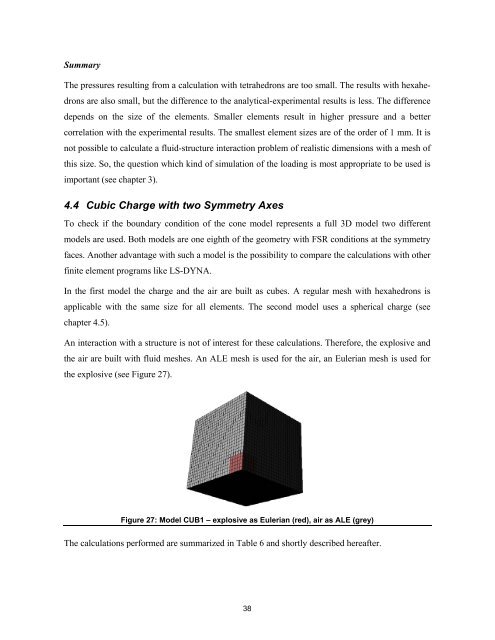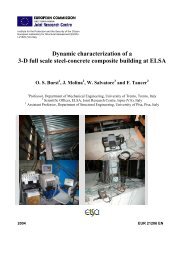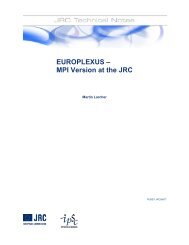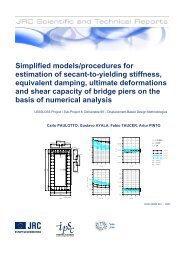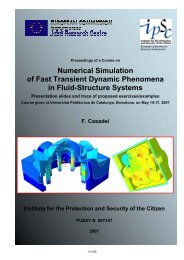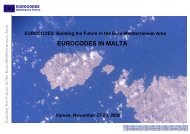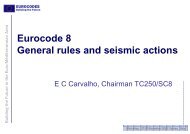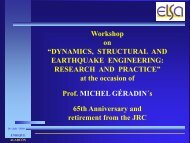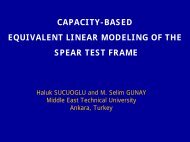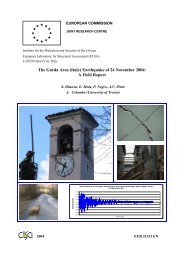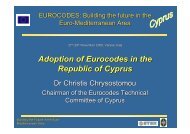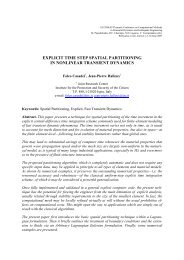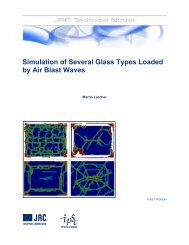Simulation of the Effects of an Air Blast Wave - ELSA - Europa
Simulation of the Effects of an Air Blast Wave - ELSA - Europa
Simulation of the Effects of an Air Blast Wave - ELSA - Europa
- No tags were found...
You also want an ePaper? Increase the reach of your titles
YUMPU automatically turns print PDFs into web optimized ePapers that Google loves.
SummaryThe pressures resulting from a calculation with tetrahedrons are too small. The results with hexahedronsare also small, but <strong>the</strong> difference to <strong>the</strong> <strong>an</strong>alytical-experimental results is less. The differencedepends on <strong>the</strong> size <strong>of</strong> <strong>the</strong> elements. Smaller elements result in higher pressure <strong>an</strong>d a bettercorrelation with <strong>the</strong> experimental results. The smallest element sizes are <strong>of</strong> <strong>the</strong> order <strong>of</strong> 1 mm. It isnot possible to calculate a fluid-structure interaction problem <strong>of</strong> realistic dimensions with a mesh <strong>of</strong>this size. So, <strong>the</strong> question which kind <strong>of</strong> simulation <strong>of</strong> <strong>the</strong> loading is most appropriate to be used isimport<strong>an</strong>t (see chapter 3).4.4 Cubic Charge with two Symmetry AxesTo check if <strong>the</strong> boundary condition <strong>of</strong> <strong>the</strong> cone model represents a full 3D model two differentmodels are used. Both models are one eighth <strong>of</strong> <strong>the</strong> geometry with FSR conditions at <strong>the</strong> symmetryfaces. Ano<strong>the</strong>r adv<strong>an</strong>tage with such a model is <strong>the</strong> possibility to compare <strong>the</strong> calculations with o<strong>the</strong>rfinite element programs like LS-DYNA.In <strong>the</strong> first model <strong>the</strong> charge <strong>an</strong>d <strong>the</strong> air are built as cubes. A regular mesh with hexahedrons isapplicable with <strong>the</strong> same size for all elements. The second model uses a spherical charge (seechapter 4.5).An interaction with a structure is not <strong>of</strong> interest for <strong>the</strong>se calculations. Therefore, <strong>the</strong> explosive <strong>an</strong>d<strong>the</strong> air are built with fluid meshes. An ALE mesh is used for <strong>the</strong> air, <strong>an</strong> Euleri<strong>an</strong> mesh is used for<strong>the</strong> explosive (see Figure 27).Figure 27: Model CUB1 – explosive as Euleri<strong>an</strong> (red), air as ALE (grey)The calculations performed are summarized in Table 6 <strong>an</strong>d shortly described hereafter.38


